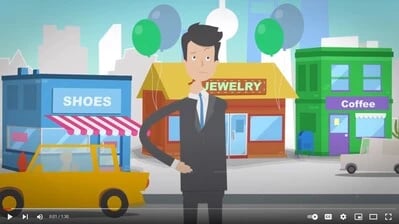Updated August 1, 2024
Cross-selling and upselling in retail are the foundations of raising the average ticket. Cross-selling in retail is the art of suggesting additional, complementary products to someone who has already decided on a purchase.
Here's one of my examples of upselling:
Think of restaurant servers who automatically ask, "Do you want a scoop of vanilla ice cream with that?" when you order a piece of pie or cake.
This product upsell example has been used for years, and for good reason. It simply and elegantly illustrates the point and best practices of cross-selling.
You've already decided you're going to treat yourself. The server has made a sale. Then the server comes back to offer you ice cream, too. Why? Because they know that vanilla ice cream goes great with pie or cake. They've offered you additional value while potentially earning themselves extra revenue...and a higher tip, don't forget.
So, you think to yourself:
"I like ice cream. Ice cream would be tasty right now. It's only a little more money to get more out of my order. Ok, I'll go with the a la mode."
The server has successfully employed the necessary upselling techniques for cross-selling, and you've got an extra treat.
Everybody wins.
Selling is nothing more than a transference of feeling - I can easily share that because I feel good about products or services.
How does upselling work in a retail business? While the products differ significantly, the selling strategy, techniques, and approaches are surprisingly similar.
Cross-Selling Tips for Retailers
Cross-selling is about boosting the foot traffic already entering your retail store doors. You want to maximize your per-customer sales and give your customers more bang for their buck.
As importantly, you want to increase your product sales while the merchandise is new, and before you may have to mark it down.
Suggestive selling isn't about trickery or misdirection; it's an honest effort to provide valuable additions while earning extra revenue.
Here are four ways to master cross-selling in retail:
The key to successful cross-selling in retail is to put your customer’s needs first. Using your expert knowledge of your store’s products, you can help them shop without making them feel pressured or setting yourself up for a “no.”
Use these expert cross-selling techniques to create a positive shopping experience while increasing your store’s bottom line.
1. Know your pairings
Before a shopper ever walks into the store, you should have a broad selection of complementary products in mind. You obviously can't upsell every item in the store, but you should have the general categories down pat.
Examples of upselling include shoes and handbags, ties and blazers, watches, and cufflinks. When somebody purchases from one category, you should consider upselling all the complementary categories for that item.
If you are the manager, during downtimes, you can create scenarios and have your employees suggest their pairing of merchandise. Make sure they justify what they selected and ask them to explain their logic.
2. Make it Relevant
Remember, this adding-on sales technique only works when it provides additional value to the shopper. This isn't like buying two boxes of Girl Scout cookies for a young woman to go to summer camp.
Keep your upselling suggestions relevant to the primary product and the customer's interests. The rapport you build with your customers before you ever get to the product will help make product recommendations that resonate and increase customer satisfaction.
They'll tell you everything you need to know about themselves and how they intend to use the merchandise. From there, you can choose which additional items are most relevant.
3. Showcase items
Complementary items and common pairings should be prominently displayed on the sales floor. It's easier to cross-sell to customers from a display when they can clearly see how the pairings work together. If you have to walk across the store to find a blazer to match a tie, you'll likely lose out on an upsell along the way.
Relevant products should be kept near each other. I can't tell you how many retailers put socks, for example, across the store from the shoes and miss out on suggestively selling what are the easy cross-product sales.
4. Be reasonable
If a shopper buys a $500 blazer, it makes sense to suggest a $50 tie; but if a customer buys a $50 tie, don't try to sell them a $500 blazer. The suggested item shouldn't exceed a certain percentage of the cost of the original item. Some put this figure at 25%, while others have a different number. You'll find what works for your customers. Instead of that blazer, how about a nice $20 set of brass collar stays?
One thing to avoid is asking the shopper to look at a premium item without knowing the right selling strategies. The easiest answer for that customer to offer is “How much?” quickly followed by “No.”
When you do this without preparing the customer, both of you lose. While they may save some money, they lose out on benefits they didn’t recognize, and you miss a chance to upsell. Your customer loyalty will likely take a hit as they revert to an online retailer to make the sale later.
Take the initiative and increase enthusiasm to interest them in the high-end items. Let them follow your lead and use your excitement to feed their excitement to build customer retention and profits.

See also: How To Boost Retail Sales With Suggestive Selling
Why cross-selling in retail works
These cross-selling tips form an upsell strategy for raising your average ticket.
Why?
A customer who says “yes” to buying your product will open their wallet again. Another upselling suggestion avoids the friction you overcame to get the first “yes.”
A good offering of complementary products naturally completes the shopping journey. As a bonus, the customer gets everything they need, not just what they asked for. That results in greater customer loyalty and increased customer satisfaction.

